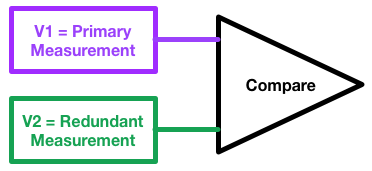|
ASIL Accuracy
ASIL accuracy describes the maximum possible deviation of a measurement in a system in which a single point fault occurred before some diagnostic detects this fault. This concept applies to automotive systems designed under the ISO 26262, ISO-26262 methodology for automotive functional safety, which defines Automotive Safety Integrity Level, Automotive Safety Integrity Levels (ASILs) to classify risks. While Accuracy and precision, accuracy refers to a single measurement, ASIL accuracy considers variation in the primary measurement being assessed as well as variation in the diagnostic measurement or measurements used to detect single point faults. How to calculate A conceptually simple implementation incorporates a fully redundant measurement. A fault in the primary measurement can be detected by comparing the primary and diagnostic measurements, and signaling a fault if the difference is outside the expected operating range. If the two measurements are truly independent and u ... [...More Info...] [...Related Items...] OR: [Wikipedia] [Google] [Baidu] |
ISO 26262
ISO 26262, titled "Road vehicles – Functional safety", is an international standard for functional safety of electrical and/or electronic systems that are installed in serial production road vehicles (excluding mopeds), defined by the International Organization for Standardization (ISO) in 2011, and revised in 2018. Overview of the Standard Functional safety features form an integral part of each automotive product development phase, ranging from the specification, to design, implementation, integration, verification, validation, and production release. The standard ISO 26262 is an adaptation of the Functional Safety standard IEC 61508 for Automotive Electric/Electronic Systems. ISO 26262 defines functional safety for automotive equipment applicable throughout the lifecycle of all automotive electronic and electrical safety-related systems. The first edition (ISO 26262:2011), published on 11 November 2011, was limited to electrical and/or electronic systems installed in ... [...More Info...] [...Related Items...] OR: [Wikipedia] [Google] [Baidu] |
Automotive Safety Integrity Level
Automotive Safety Integrity Level (ASIL) is a risk classification scheme defined by the ISO 26262 - Functional Safety for Road Vehicles standard. This is an adaptation of the Safety Integrity Level (SIL) used in IEC 61508 for the automotive industry. This classification helps defining the safety requirements necessary to be in line with the ISO 26262 standard. The ASIL is established by performing a risk analysis of a potential hazard by looking at the Severity, Exposure and Controllability of the vehicle operating scenario. The safety goal for that hazard in turn carries the ASIL requirements. There are four ASILs identified by the standard: ASIL A, ASIL B, ASIL C, ASIL D. ASIL D dictates the highest integrity requirements on the product and ASIL A the lowest. Hazards that are identified as QM do not dictate any safety requirements. Hazard Analysis and Risk Assessment Because of the reference to SIL and because the ASIL incorporate 4 levels of hazard with a 5th non-hazardous le ... [...More Info...] [...Related Items...] OR: [Wikipedia] [Google] [Baidu] |
Accuracy And Precision
Accuracy and precision are two measures of ''observational error''. ''Accuracy'' is how close a given set of measurements (observations or readings) are to their ''true value''. ''Precision'' is how close the measurements are to each other. The International Organization for Standardization (ISO) defines a related measure: ''trueness'', "the closeness of agreement between the arithmetic mean of a large number of test results and the true or accepted reference value." While ''precision'' is a description of ''random errors'' (a measure of statistical variability), ''accuracy'' has two different definitions: # More commonly, a description of ''systematic errors'' (a measure of statistical bias of a given measure of central tendency, such as the mean). In this definition of "accuracy", the concept is independent of "precision", so a particular set of data can be said to be accurate, precise, both, or neither. This concept corresponds to ISO's ''trueness''. # A combination of both ... [...More Info...] [...Related Items...] OR: [Wikipedia] [Google] [Baidu] |
